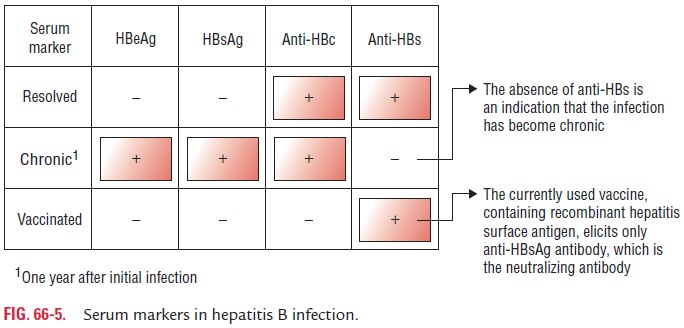Chapter: Microbiology and Immunology: Virology, Virus: Arboviruses
Laboratory Diagnosis - Hepatitis B Virus Infections
Laboratory Diagnosis
Laboratory diagnosis plays an important role to confirm the HBV etiology of hepatitis.
◗ Specimen
Serum is an important specimen because definitive diagnosis of HBV depends on serological testing for HBV infections.
◗ Serodiagnosis
Diagnosis of acute infection is made by demonstration of HBsAg as well as HBeAg in the serum. Both HBsAg and HBeAg are the important serum markers of acute HBV. They indicate viral replication. When viral replication slows, HBeAg disappears and anti-HBeAg is detected. Hepatitis B surface antibody (HBsAb) produced may persist for many years. This is followed by demonstration of IgM antibodies against hepatitis B core antigen (HBcAb).
HBsAb: HBsAb is a protective antibody that neutralizes thevirus and is usually not detectable during the acute disease since it forms immune complex with HBsAg because it is bound to the large amount of HBsAg present in blood. It is also not detectable in the chronic carrier stage.
HBcAb: Demonstration of HBcAb is useful to confirm thediagnosis of HBV infection. Total HBcAb including IgM and IgG antibodies indicates exposure to the virus and viral replication. The HBcAb appears shortly after HBsAg in acute disease and persists for life. Detection of IgM HBcAb is diagnostic of acute HBV infection during window phase. The HBcAb are present in individuals with acute infection, chronic infections, and also in those who have recovered from acute infection. Therefore, the presence of HBcAb IgG does not differentiate between acute and chronic infection. HBcAg is not detectable in the serum, but can be demonstrated in the liver cells by immunofluorescence.
HBeAg: HBeAg is present in the blood during the incubationand also during the prodrome and early acute disease. This is also present in certain chronic carriers. The presence of HBeAg indicates a high likelihood of infectivity and transmissibility. Chronic replication of HBV is characterized by the presence of circulating HBsAg, HBeAg usually with HBcAg. Both HBsAg and HBeAg are not present in serum during convalescence. Serum IgG antibodies to HBsAg, HBcAg, and HBeAg appear during the stage of convalescence.

In essence, hepatitis B serology is useful to describe the course and nature of the disease. Acute and chronic HBV infection can be differentiated by the presence of HBsAg and HBeAg in the serum and distribution pattern of the antibodies to the individuals’ HBV antigen (Fig. 66-5). Interpretation of common serological markers in HBV infection is summarized in Table 66-3.

◗ Other tests
These tests include elevation of ALT and AST. High levels are found in acute hepatitis (1000–2000 IU/mL). Estimation of serum bilirubin indicates the intensity of jaundice.
Related Topics